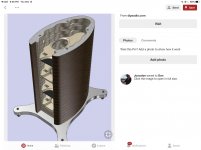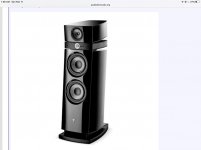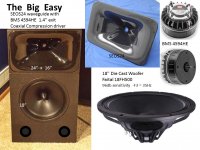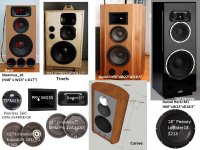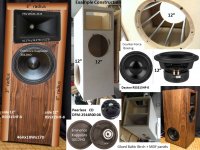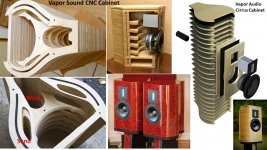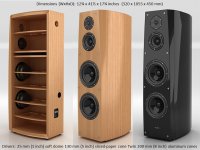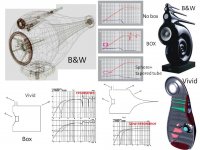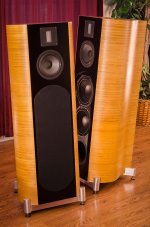A bit about myself . I’m 57 years old , and come from a car audio background . Personally I dislike passive crossover networks, and would sooner go all active , but a bunch of independent amplifiers are not something I’d really want the expense of at this point , so I’ll have to study passive x-overs .
I’m not building speakers anytime soon , but something I’d like to research and possibly do for a winter project . If all goes well I may have a cnc router table next year .
I have always wondered if I could build a pair of speakers that had superior sound to my paradigm Studio 100V5’s for music . I have been studying raw drivers ,and from what I’m seeing it looks like ScanSpeak is a good choice . I was looking at Sony’s AR1 towers that retail for $27000 , and noticed they look like there using Scanspeak drivers of all things . So Scanspeak drivers can’t be all that bad .
I should mention that I’d still have a separate subwoofer regardless of there capabilities.
Here’s my list of drivers I’d like to implement. Because I don’t want really wide enclosures,I’d opt for there 11” woofer . Not sure if a guy should go with two 11” woofers per enclosure instead of one . I’ve always felt that if a driver was using half its excursion for a given volume, it should have a cleaner sound . I believe they make them in an 8 ohm version also.
Scan-Speak Revelator 11" Subwoofer - 28W/4878T00
For Midrange driver I’d choose Scan-Speak 18M/4631T
And for a tweeter I’m not sure if I’d go with there Beryllium tweeter ScanSpeak D2908/7140 Beryllium Dome Revelator Tweeter
Or this one . I’ve heard good things about this tweeter on Audioholics ScanSpeak Revelator D2905/9900-00 1" Tweeter Textile Dome
My theory for an enclosure is to have curved sides , as I find that more attractive and it should be beneficial to eliminate standing waves . I like the design of Focals Sopra and Utopia series . The drivers are tilted towards the listener . I’m not sure I like the idea of having sections that can be moved like the Utopia series ,as I’d be concerned about diffraction issues having sharp horizontal edges close to the tweeter like that . I’ll put a few pics in of what I’d like to design .
I’m not building speakers anytime soon , but something I’d like to research and possibly do for a winter project . If all goes well I may have a cnc router table next year .
I have always wondered if I could build a pair of speakers that had superior sound to my paradigm Studio 100V5’s for music . I have been studying raw drivers ,and from what I’m seeing it looks like ScanSpeak is a good choice . I was looking at Sony’s AR1 towers that retail for $27000 , and noticed they look like there using Scanspeak drivers of all things . So Scanspeak drivers can’t be all that bad .
I should mention that I’d still have a separate subwoofer regardless of there capabilities.
Here’s my list of drivers I’d like to implement. Because I don’t want really wide enclosures,I’d opt for there 11” woofer . Not sure if a guy should go with two 11” woofers per enclosure instead of one . I’ve always felt that if a driver was using half its excursion for a given volume, it should have a cleaner sound . I believe they make them in an 8 ohm version also.
Scan-Speak Revelator 11" Subwoofer - 28W/4878T00
For Midrange driver I’d choose Scan-Speak 18M/4631T
And for a tweeter I’m not sure if I’d go with there Beryllium tweeter ScanSpeak D2908/7140 Beryllium Dome Revelator Tweeter
Or this one . I’ve heard good things about this tweeter on Audioholics ScanSpeak Revelator D2905/9900-00 1" Tweeter Textile Dome
My theory for an enclosure is to have curved sides , as I find that more attractive and it should be beneficial to eliminate standing waves . I like the design of Focals Sopra and Utopia series . The drivers are tilted towards the listener . I’m not sure I like the idea of having sections that can be moved like the Utopia series ,as I’d be concerned about diffraction issues having sharp horizontal edges close to the tweeter like that . I’ll put a few pics in of what I’d like to design .
Attachments
Last edited:
Easily. I have a friend with some of those and I much prefer mine to his in a number of different ways; dynamics, imaging, resolution and low distortion. Not to mention efficiency.I have always wondered if I could build a pair of speakers that had superior sound to my paradigm Studio 100V5’s for music .
I would also choose very different drivers to you as well as enclosure design. I'd also go active, as the benefits far outweigh the drawbacks and amplifiers are cheap.
Enjoy your build, wherever it takes you.
Before you dive headlong into some cavernous pit called loudspeaker design particularly with passive crossovers you should look at other designs by other DIY er's on other websites.
For instance...............
DIY-Loudspeakers
See what may work for you rather than taking the plunge into expensive hardware before you know what you are up against, loudspeaker design can be particularly frustrating without measurement and the necessary software.
All the best and Merry Christmas to all.
C.M
For instance...............
DIY-Loudspeakers
See what may work for you rather than taking the plunge into expensive hardware before you know what you are up against, loudspeaker design can be particularly frustrating without measurement and the necessary software.
All the best and Merry Christmas to all.
C.M
If you dislike passive XO so much, why not just forego it?
One of the pictures you posted was a cut out of wesayso's Twin Towers that are found in the Full Range section.
Plenty of dynamics, and no XO.
If your room is suitable, there's also the option to go Open Baffle.
There's always more than one way to achieve greatness.
One of the pictures you posted was a cut out of wesayso's Twin Towers that are found in the Full Range section.
Plenty of dynamics, and no XO.
If your room is suitable, there's also the option to go Open Baffle.
There's always more than one way to achieve greatness.
I was watching a video and the guy was measuring pink noise with a Mic and some software on a laptop . . He mentions what he’s using , but not sure if it’s free software or something that costs a lot . It was very interesting learning about diffraction issues , and also peaks and nulls at the crossover frequency created from drivers being out of phase .Before you dive headlong into some cavernous pit called loudspeaker design particularly with passive crossovers you should look at other designs by other DIY er's on other websites.
For instance...............
DIY-Loudspeakers
See what may work for you rather than taking the plunge into expensive hardware before you know what you are up against, loudspeaker design can be particularly frustrating without measurement and the necessary software.
All the best and Merry Christmas to all.
C.M
And yes , I see there’s a lot involved and lots of trial and error .
I made my cabinet shaped like Avalon and have very few diffrations - I measure them on-axis and then at multiple angles off-axis to find any big issues. My baffels are rather narrow and my drivers are 5" midrange and 1" tweeter - because it makes it easier to have better power response. I also have multiple bass drivers and four subwoofers. Bass drivers work from 90 to 500hz for optimum dynamics and less need to pump air - I believe it helps them to give more "smack". The subs are arranged to work as multiple subs, to have as even and well controlled foundation to music as possible in my room - even out of my listening position.
I shape my drivers with my DSP through gated measurements and make sure that the curves are acoustical correct, before and after I add the filters - LR4. Then I compare the peak of the impulses from both midrange and tweeter, to find the optimum delay for the tweeter, so that the filters sum - and this mostly gives me a very nice straight response from around 700hz to above 20Khz.
I also use as few corrections in the DSP to get an even response. This is done with respect to the fact, that we can mostly not easily hear high Q peaks/nulls, but if the Q is low(wide), then just one dB, can be very annoying.
I think of this, as if the total area (mathematical) under a given curve, is equal to the total amount of energy and therefore equal to how easy it is to hear.
I shape my drivers with my DSP through gated measurements and make sure that the curves are acoustical correct, before and after I add the filters - LR4. Then I compare the peak of the impulses from both midrange and tweeter, to find the optimum delay for the tweeter, so that the filters sum - and this mostly gives me a very nice straight response from around 700hz to above 20Khz.
I also use as few corrections in the DSP to get an even response. This is done with respect to the fact, that we can mostly not easily hear high Q peaks/nulls, but if the Q is low(wide), then just one dB, can be very annoying.
I think of this, as if the total area (mathematical) under a given curve, is equal to the total amount of energy and therefore equal to how easy it is to hear.
Last edited:
I'm really courious - are they better now? Heard alot of beginner problems with them, like level sensitivity to auto-start, software issues and so on. It seems like miniDSP is a bit more stable and easy to handle. But I'm guessing - I use groundsound products.
Fun to see one of my pictures being used as inspiration.

If you want to know more about it, there's lots more here:
The making of: The Two Towers (a 25 driver Full Range line array)
By the way, an array like that isn't a bad way to avoid crossovers (lol).

If you want to know more about it, there's lots more here:
The making of: The Two Towers (a 25 driver Full Range line array)
By the way, an array like that isn't a bad way to avoid crossovers (lol).
I'm really courious - are they better now? Heard alot of beginner problems with them, like level sensitivity to auto-start, software issues and so on. It seems like miniDSP is a bit more stable and easy to handle. But I'm guessing - I use groundsound products.
Had a quick look at groundsound stuff... quite expensive!
I have no experience with them, so I can't compare.
miniDSP has a new line called the SHD.
Reviews and measurements were very good.
Review and Measurements of miniDSP SHD DAC, DSP And Streamer | Audio Science Review (ASR) Forum
Fun to see one of my pictures being used as inspiration.
I love the way the inside has all the curved edges . Not sure how the volume calculations we’re done with all the uneven surfaces . I have a few ideas how though .
It looks about as solid as it gets also 🙂
Last edited:
I'm really courious - are they better now? Heard alot of beginner problems with them, like level sensitivity to auto-start, software issues and so on. It seems like miniDSP is a bit more stable and easy to handle. But I'm guessing - I use groundsound products.
I was looking at the mini dsp , as it does all I’d like . Especially liking that it does time alignment also. But it didn’t get great reviews on one site that tested it.
The distortion they were seeing would probably never be heard regardless though .
But the Mini Dsp was my first idea , use class A amps for the mid and tweet , and a class D for the woofers .
If I had a dedicated room for music listening,I’d definitely go that route
Last edited:
Invest some study time on designs which use waveguides/horns for controlled directivity. Read Dr. Earl Geddes paper on controlled directivity, and also read the current thread on the in-room interactions between normal direct radiating speakers vs horn/waveguide designs. Some find that the best sound is not the most accurate measured on-axis response.
----------
http://www.gedlee.com/Papers/directivity.pdf
The Preference for Direct Radiators
-----
If you decide to build a direct radiating speaker, klone the best AVALON beveled baffle design for your needs, OR use your CNC to minic the genius translam VAPOR AUDIO designs:
-large radius on baffle edges for low diffraction
-tapered rear volumes for resonance reduction
-integrated 3D bracing
-pockets for wool absorption reduction
-pockets for sand vibration reduction
========
========
Three interesting large 3-way waveguide designs which could fit your goals.
--------
The BMF1 speaker custom-built by Tweek Geek has received high praise in public shows. The use of two-sealed, near-floor, side-side, counter-force, DSP-controlled woofers provides powerful deep bass in a medium size 6cuft cabinet. The Tweek Geek website has several construction pictures,
HIGH-watts to two 24Hz equalized 12" woofers allows a modest H46" W18" D17" total 6cuft cabinet that fits many homes. The Eminence Kappalite 3012HO was selected for the midwoofer based upon the $188 price, datasheet measurements and user feedback "dynamic and natural sound".
$13 B-52 PHRN-1014 1" Horn 10" x 14" Bolt-On waveguide
Model: PHRN-1014|Part # 299-2303
$63 Peerless 1.75" DFM-2544R00-08 compression driver
$188 Eminence KappaLite 3012HO Midrange:
|Model: Kappalite 3012LF |Part # 290-590 |$189
TWO $156 Dayton RSS315HF-4 12" woofer (two in series = 6.2 ohms)
-------------------------
$576 for drivers
34 best Tweek Geek's BMF Speaker in the making images on Pinterest | Geek stuff, Geek things and Music speakers
==========
"The Big Easy" 2-driver build uses the SEOS-24 waveguide with the new BMS 4594HE_Nd coaxial compression driver to cover 500-20,000Hz with excellent pattern control. One 18" woofer (AES TD18H+ or Faital 18FH500) offers high efficiency with a large... but easy to build big cabinet for about $1200/speaker for parts. Complete build info on AVS forum.
==========
Classic Large Monitors using 18" woofer + 12" midwoofer + horn tweeter for $550 - $ 600/speaker parts
$13 B-52 PHRN-1014 1" Horn 10" x 14" Bolt-On waveguide
Model: PHRN-1014|Part # 299-2303
$63 Peerless 1.75" DFM-2544R00-08 compression driver
$188 Eminence KappaLite 3012HO Midrange:
|Model: Kappalite 3012LF |Part # 290-590 |$189
$215 Peavey LoRider 18" woofer/subwoofer options
---18" Peavey Low Rider 00479910 Mms 163gm •Qts 0.343 •Fo (Hz): 28.9
---18" Peavey Low Rider Subwoofer 00560600 Mms 198.20gm •Qts: 0.429 •Fo (Hz): 28.9
----------
http://www.gedlee.com/Papers/directivity.pdf
The Preference for Direct Radiators
-----
If you decide to build a direct radiating speaker, klone the best AVALON beveled baffle design for your needs, OR use your CNC to minic the genius translam VAPOR AUDIO designs:
-large radius on baffle edges for low diffraction
-tapered rear volumes for resonance reduction
-integrated 3D bracing
-pockets for wool absorption reduction
-pockets for sand vibration reduction
========
========
Three interesting large 3-way waveguide designs which could fit your goals.
--------
The BMF1 speaker custom-built by Tweek Geek has received high praise in public shows. The use of two-sealed, near-floor, side-side, counter-force, DSP-controlled woofers provides powerful deep bass in a medium size 6cuft cabinet. The Tweek Geek website has several construction pictures,
HIGH-watts to two 24Hz equalized 12" woofers allows a modest H46" W18" D17" total 6cuft cabinet that fits many homes. The Eminence Kappalite 3012HO was selected for the midwoofer based upon the $188 price, datasheet measurements and user feedback "dynamic and natural sound".
$13 B-52 PHRN-1014 1" Horn 10" x 14" Bolt-On waveguide
Model: PHRN-1014|Part # 299-2303
$63 Peerless 1.75" DFM-2544R00-08 compression driver
$188 Eminence KappaLite 3012HO Midrange:
|Model: Kappalite 3012LF |Part # 290-590 |$189
TWO $156 Dayton RSS315HF-4 12" woofer (two in series = 6.2 ohms)
-------------------------
$576 for drivers
34 best Tweek Geek's BMF Speaker in the making images on Pinterest | Geek stuff, Geek things and Music speakers
==========
"The Big Easy" 2-driver build uses the SEOS-24 waveguide with the new BMS 4594HE_Nd coaxial compression driver to cover 500-20,000Hz with excellent pattern control. One 18" woofer (AES TD18H+ or Faital 18FH500) offers high efficiency with a large... but easy to build big cabinet for about $1200/speaker for parts. Complete build info on AVS forum.
==========
Classic Large Monitors using 18" woofer + 12" midwoofer + horn tweeter for $550 - $ 600/speaker parts
$13 B-52 PHRN-1014 1" Horn 10" x 14" Bolt-On waveguide
Model: PHRN-1014|Part # 299-2303
$63 Peerless 1.75" DFM-2544R00-08 compression driver
$188 Eminence KappaLite 3012HO Midrange:
|Model: Kappalite 3012LF |Part # 290-590 |$189
$215 Peavey LoRider 18" woofer/subwoofer options
---18" Peavey Low Rider 00479910 Mms 163gm •Qts 0.343 •Fo (Hz): 28.9
---18" Peavey Low Rider Subwoofer 00560600 Mms 198.20gm •Qts: 0.429 •Fo (Hz): 28.9
Attachments
The Sony AR1 uses ScanSpeaker drivers, with a selected narrow range of T/S parameters. The Sony AR1 repair manual contains the passive crossover schematic, which I have in case you cannot download the material from the Sony website. There are accurate high definition AR1 graphics on the web.
Attachments
Great information guys , thanks .
This kit is proven and has all the specs available.
B1371 Scan-Speak Kit by Peter Noerbaek - Pair
I’d want to substitute the 13” for one or two 11” though . Obviously the enclosure volume and port would change . Not sure if the crossover would have to be changed
This kit is proven and has all the specs available.
B1371 Scan-Speak Kit by Peter Noerbaek - Pair
I’d want to substitute the 13” for one or two 11” though . Obviously the enclosure volume and port would change . Not sure if the crossover would have to be changed
Had a quick look at groundsound stuff... quite expensive!
I have no experience with them, so I can't compare.
Be careful saying that Ground Sound is expensive. You'll get the longest and angriest PM of your life from the owner!
Some years ago when I was thinking about creating an active speaker and wrote on a Danish forum looking for options.
Somebody suggested Ground Sound and i said it was too expensive for me(Was a student at the time) and i got the longest and angriest PM ever! Saying how it is not expensive at all for what it is and according to his accountant it's the right price and so on.
Now I can afford their equipment. But I'm never buying from that company... EVER!
Last edited:
Guys I have a question about the midrange driver . Say I was to use scan speaks 7” revelator. Besides using fill and there recommended volume in its own separate enclosure , I was wondering if a guy should spray the inside of its enclosure with that rubber coating spray ?
My theory is it’s best to not have those higher frequencies bounce off a hard surface .
If I followed my stacked wall idea with uneven walls , that would help with standing waves , but I thought a coating on the inner walls might take it to the next level .
Anyone try this ?
Scan-Speak 18M/4631T
besides stuffing the midrange driver section and having uneven surfaces to avoid
My theory is it’s best to not have those higher frequencies bounce off a hard surface .
If I followed my stacked wall idea with uneven walls , that would help with standing waves , but I thought a coating on the inner walls might take it to the next level .
Anyone try this ?
Scan-Speak 18M/4631T
besides stuffing the midrange driver section and having uneven surfaces to avoid
Spraying liquid rubber can reduce panel vibrations, but you want to invest in cross bracing before spending on a spray material.
Heavy wool / fiberglass stuffing will absorb cavity resonances, but many experts claim it also affects transient reproduction. Tapering the air volume behind the driver and using a modest amount of stuffing is proven to reduce resonances without sucking the life out of dynamic music. In a basic box, putting a "V-brace" behind the midrange creates a tapered volume.
In post #13 I recommended:
use your CNC to minic the genius translam VAPOR AUDIO designs:
-large radius on baffle edges for low diffraction
-tapered rear volumes for resonance reduction
-integrated 3D bracing
-pockets for wool absorption reduction
-pockets for sand vibration reduction
========
COPY OFF THE SMART KIDs.
Heavy wool / fiberglass stuffing will absorb cavity resonances, but many experts claim it also affects transient reproduction. Tapering the air volume behind the driver and using a modest amount of stuffing is proven to reduce resonances without sucking the life out of dynamic music. In a basic box, putting a "V-brace" behind the midrange creates a tapered volume.
In post #13 I recommended:
use your CNC to minic the genius translam VAPOR AUDIO designs:
-large radius on baffle edges for low diffraction
-tapered rear volumes for resonance reduction
-integrated 3D bracing
-pockets for wool absorption reduction
-pockets for sand vibration reduction
========
COPY OFF THE SMART KIDs.
Attachments
That’s interesting . Didn’t really think any bracing was necessary in a chamber that only housed a midrange .Spraying liquid rubber can reduce panel vibrations, but you want to invest in cross bracing before spending on a spray material.
Heavy wool / fiberglass stuffing will absorb cavity resonances, but many experts claim it also affects transient reproduction. Tapering the air volume behind the driver and using a modest amount of stuffing is proven to reduce resonances without sucking the life out of dynamic music. In a basic box, putting a "V-brace" behind the midrange creates a tapered volume.
.
Will have to try implementing something like that
I would be cautious with rubber coats. They use deliberate amount of vapourizing diluents, which hardly ever totally disappear. These are likely to soften the glued parts of the driver, first of all the surround rubber and spider. It is regular treatment in car audio, but for hifi speakers with thick walls, benefit is questionable
An enclosure has many different resonances, standing waves and internal reflections with high order (multiples). Size is important, avoiding parallel walls, structural stiffness and for midrange wool stuffing and surface coating with felt or similar material are the key elements.
MT, study the web pages mentioned before. Look at the fundamentals behind choosing driver size and type, enclosure construction and dimensions etc. and how they came.
With passive speakers bass woofer is always a real problem, actives are much easier. You must consider Xmax and tuning and size of reflex port. For active I recommend closed with eq.
For mid in a 3-way I wouldn't go larger than 5" (130mm) membrane diameter to get smooth directivity with tweeter. The midrange can never be too good, put most of your money in it! With xo in range of 300-500Hz, the box should be closed and only just couple of liters. SEAS W15 Nextel, SS Revelator 15M, SBA Satori MR13P and alike. For extreme, consider Accuton Cell.
For tweeter, you have lots of choices and wide price range, hard to go wrong. No real need to go to extremes, but new BliesMAs are practically the best money can buy!
An enclosure has many different resonances, standing waves and internal reflections with high order (multiples). Size is important, avoiding parallel walls, structural stiffness and for midrange wool stuffing and surface coating with felt or similar material are the key elements.
MT, study the web pages mentioned before. Look at the fundamentals behind choosing driver size and type, enclosure construction and dimensions etc. and how they came.
With passive speakers bass woofer is always a real problem, actives are much easier. You must consider Xmax and tuning and size of reflex port. For active I recommend closed with eq.
For mid in a 3-way I wouldn't go larger than 5" (130mm) membrane diameter to get smooth directivity with tweeter. The midrange can never be too good, put most of your money in it! With xo in range of 300-500Hz, the box should be closed and only just couple of liters. SEAS W15 Nextel, SS Revelator 15M, SBA Satori MR13P and alike. For extreme, consider Accuton Cell.
For tweeter, you have lots of choices and wide price range, hard to go wrong. No real need to go to extremes, but new BliesMAs are practically the best money can buy!
Last edited:
- Status
- Not open for further replies.
- Home
- Loudspeakers
- Multi-Way
- DIY Speaker dream build
